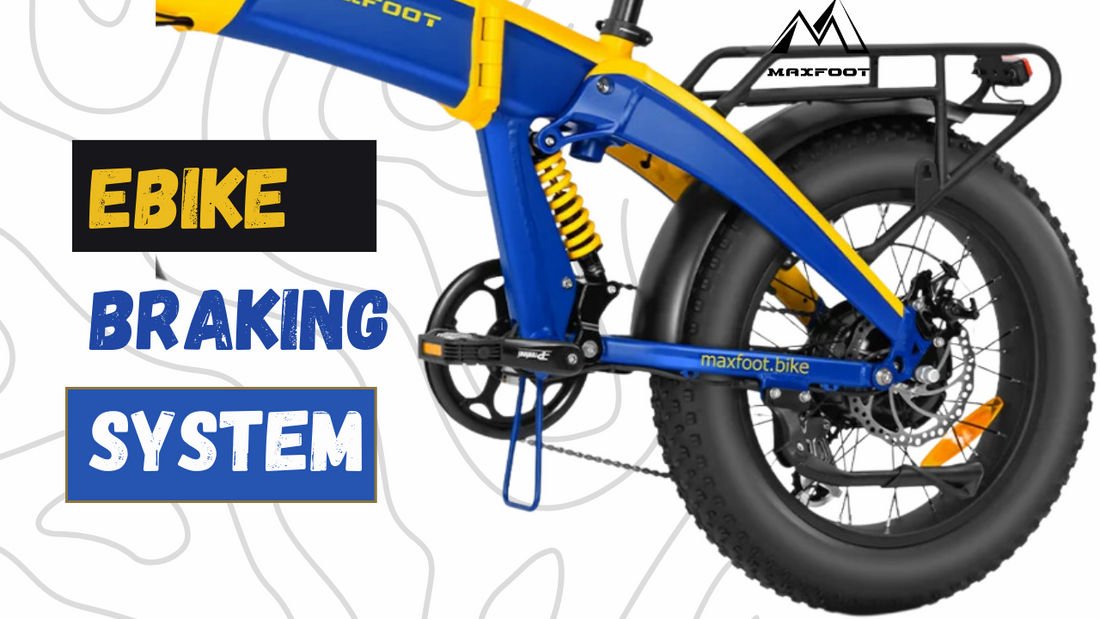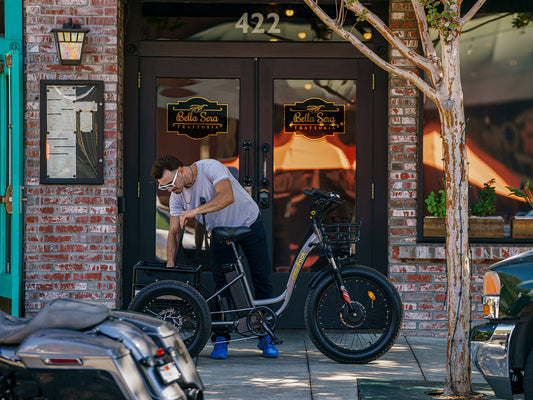Everything ends, even the joyful ride on your ebike. And when it’s time to bring that ride to a halt, the reliability of your braking system becomes paramount. This system is key for our safety and control of the vehicle.
But how does this system work? Is it like what we see in traditional bikes, or are there changes? Let's dive into this comprehensive guide and find out.
How Does a Typical Ebike Braking System Work?
It all starts when you pull the brake lever. This action applies pressure to the caliper’s pistons through a cable system. The pistons, attached to the calipers, then exert force on the brake pads. These pads press down on the brake rotors.
The key here is friction. The force between the brake pads and the rotors creates friction, which generates the stopping power needed to slow down or stop your bike. The harder you pull on the brake lever, the more force is applied to the brake pads, allowing you to stop more quickly. But there’s a catch – this friction also produces heat, which can affect braking performance.
This is something you see in traditional bicycles as well. Now, here’s where ebikes add a twist: the motor cutoff switch. When you apply the brakes, this switch automatically cuts power to the motor. This is important because it prevents any accidental acceleration while braking, ensuring a safer and more controlled stop.
Components of an Ebike Braking System
Now, let’s further break down each component involved in ebike braking system:
Levers
Brake levers are mounted on the handlebar and are essential for activating the braking system. Normally, the left lever controls the front wheel, and the right lever controls the rear brake. However, this can vary depending on regional standards.
Motor Cutoff Switch
The motor cutoff switch, a unique feature in ebikes, is integrated into the braking system. This may be legally required in some states. When the lever is pulled, this switch sends a signal to the motor controller to turn off the motor. So, that that the motor and brakes aren't used simultaneously for safety.
Cables
Steel cables connect the brake levers to each wheel. The braking force travels from the lever to the caliper via these cables. In many electric bikes, especially those with mechanical disc brakes, these cables are essential for transmitting the force needed to activate the brakes.
Caliper and Braking Pads
The caliper is a central housing unit containing the brake pads. These pads create the necessary friction needed to slow down the wheels.
Some ebikes may have braking pads that require more frequent adjustments and replacements, especially when used in demanding conditions like downhill riding or carrying heavy loads.
Rotor
The rotor is a large metal disc located in the center of the wheel. It plays a vital role in the disc brake system by providing a surface for the brake pads to create friction.
Rotor sizes typically range from 160mm on commuter bikes to 220mm on electric mountain bikes. Larger rotors can stop an e-bike faster but may lead to quicker wear of the braking pads due to increased friction.
Piston
The number of pistons in a brake system can vary, with more pistons generally equating to greater stopping power. Pistons are usually found inside the master cylinder. When they move, they compress fluid or air, transferring the brake force from the lever to the rotor.
The Two Types of Braking Systems: Mechanical Vs. Hydraulic Brakes
Braking system come in various form based on how the power the force is transmitted from handle bar to the tires. In ebikes, two types are quite common. Mechanical brakes and hydraulic brakes.
Mechanical Brakes
Mechanical disc brakes use a cable system to activate the braking mechanism. When the brake lever is pulled, the cable tightens, causing the calipers to clamp the brake pads onto the rotor, creating the friction needed to slow down the bike. They are most common brake pads and generally the first choice for most ebike manufacturers as they are much cheaper compared to other options.
Pros:
- Generally, less expensive than hydraulic brakes.
- Simpler design makes them easier for DIY repairs and adjustments.
- Perform well in different weather conditions.
Cons:
- Requires more physical effort to achieve the same level of braking.
- Cable stretch over time can require more frequent adjustments.
Hydraulic Disc Brakes
Hydraulic disc brakes use a sealed, fluid-filled system to transfer force from the brake lever to the brake calipers. When the lever is pulled, it pushes fluid through a hose, exerting pressure on the caliper pistons, which then clamp the brake pads onto the rotor.
Pros:
- Require less manual force for braking, offering a smoother experience.
- Automatically adjust for brake pad wear, reducing maintenance.
- Offer more control over the braking process, allowing for finer adjustments.
Cons:
- More expensive than mechanical disc brakes.
- The hydraulic system can be compromised by air bubbles or fluid leaks.
Regenerative Braking: Do ebikes have that?
Regenerative braking in ebikes works on a principle similar to that in electric cars: it recoups energy during braking. However, it’s very uncommon in ebikes and we don’t see manufacturers adding this feature. This is due to multiple reasons:
- Brief Braking in Bicycles:Unlike cars, braking in bicycles is typically brief. Cyclists often prefer to coast, especially downhill, to gain speed. This behavior reduces the opportunities for regenerative braking to recapture a significant amount of energy.
- Efficiency Concerns: The efficiency of regenerative braking systems in ebikes isn't as high as in cars. This isn't due to a flaw in the technology itself but rather because of the way bicycles are ridden. The less frequent and shorter duration of braking in bikes means there's less opportunity to recapture energy.
- Limited to Specific Motor Types: Regenerative braking is primarily compatible with certain types of hub motors. It is not easily adaptable to mid-drive e-bike systems, which limits its applicability across different ebike models.
- Cycling Dynamics: The dynamics of cycling differ significantly from driving. In cars, factors like speed limits and traffic often lead to more frequent and prolonged braking, making regenerative braking more effective. In contrast, cyclists tend to use brakes less consistently, making the energy recapture process less efficient.
Conclusion
Sometimes stops are good, and brake pads let you take that necessary break. They are one of the key components that ensure not only your safety but also the safety of others around you.
At Maxfoot, our aim is to provide safe and cost-effective biking solutions. Our bikes are equipped with the well-known Tektro 180 mm rotor disc brake pads, renowned for their reliability and efficiency.
With Maxfoot, you can ride with confidence, knowing that your safety is backed by quality and dependable braking technology.




